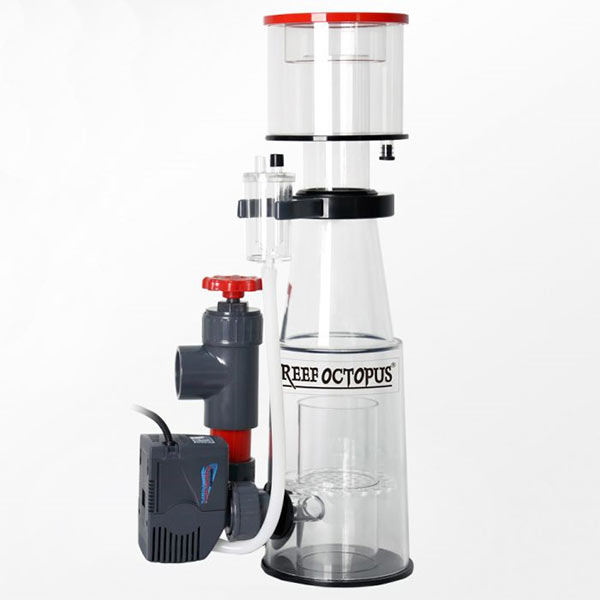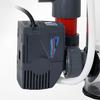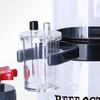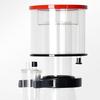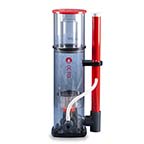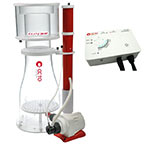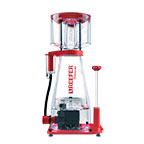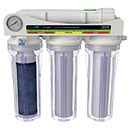Additional sizes may be available!
Additional sizes may be available! Email me when available|
Product Notes:
· We cannot ship this product to Alaska. |
Overview
| * | High performance in-sump skimmer with pinwheel impeller |
| * | Micro-bubbles effectively removes dissolved organic waste |
| * | Half cone hybrid skimmer body boosts foamate collection |
Hybrid in-sump skimmer loaded with premium features maintain cleaner, clearer aquarium water. Reef Octopus Pinwheel In Sump Skimmer boasts a modified half cone design that allows greater foamate stabilization and collection. In other words, efficient removal of dissolved organic waste that compromises aquarium water quality and clarity!
Reef Octopus Pinwheel In Sump Skimmer is powered by Hailea OTP pumps featuring a high performance venturi air injection system and pinwheel impeller. This improved pump performance is the secret behind the enormous amount of waste removing micro-bubbles. Signature Gate Valve allows precision control of water level within the protein skimmer while quick release neck allows easy removal of collection cup to simplify cleaning. High quality acrylic construction. For in sump use only.
Please Note: The Octopus skimmer uses metric plumbing parts. Requires at least 1/2" of clearance to remove the collection cup.
Reef Octopus 4" NWB-110
Dimensions: 10" x 6-3/4" x 19-3/4" high
Powered by 1 Aquatrance 1000 pump at 250 gph
Recommended sump water level: 6"-7-3/4"
Rated for aquariums up to 100 gallons
Reef Octopus 6" NWB-150
Dimensions: 12" x 8-1/2" x 22-1/8" high
Powered by 1 OTP 2000 pump at 500 gph
Recommended sump water level: 6"-7-3/4"
Rated aquariums up to 150 gallons
For specialized technical support on your Reef Octopus purchase, please feel free to call Coral Vue at 985-718-1466.
How to Dial in a Skimmer
Trouble Dialing in your Octopus Skimmer?
All skimmers are made differently and require different settings and environments to obtain optimal performance. The instructions below are intended as a guideline to help you adjust your skimmer.
- Allow the skimmer to break in 3-4 weeks before attempting to dial it in and clean the neck regularly with only water.
- For in-sump models make sure the sumps water level is consistently right below the output tee on the skimmer (usually at 5.75-6" on most of our SRO skimmers) throughout the day. Water level stability is the key for consistent skimmer performance.
- Set the inner water level at about 3/4 the way up the skimmer body by opening and closing the valve. It will take some time (usually 3-5 hours is good but for the first time setting it up this way, leave it set for 12-24 hours) to allow the skimmer to adjust to this setting and build a solid head of foam (you should only see large air bubbles within the neck).
- After you have the inner water level and the skimmer has adjusted to this setting, you can begin to adjust the valve to obtain your choice in skimmate. The key is to make very small adjustments with the valve and leave it alone for a few hours to adjust. You may make adjustments over a period of a few days but after the initial setup, you will notice that the skimmer will begin to skim consistently and there will be little to no tweaking to do after that point. Remember opening the valve drops the inner water level and you will get a collection of dryer/darker skimmate, while closing the valve raises the water level giving you a wetter less concentrated skimmate.
- Keep up with the maintenance by cleaning out the venturi and skimmer neck. Every 4-6 months you should remove the pump and soak it in a bucket of a 40/60 mix of vinegar and water. Remove the volute and pull out the impeller to inspect for any signs of wear or debris.
Water Level
What water level should I run my in-sump protein skimmer at?
This is the question we at Reef Octopus are asked the most about in-sump protein skimmers. There really is no set depth that the skimmer needs to run in. The two things you need to maintain is to keep the pump covered with water at the "Minimum" mark or 1" above the highest point on the pump and to keep the water level in the sump below the water outlet pipe on the skimmer. You want to see the water flowing out of the skimmer and drop down into the sump water.
What impact does the sumps water level have on a skimmer?
For in-sump skimmers, sump water level stability is the key to optimal skimmer performance. We at Reef Octopus suggest that the water level within the skimmer compartment of the sump be level at all times by strategic placement of baffles or maintained by a quality auto top off unit. Skimmers can be set in a range of water depths and vary from system to system.
Skimmer Overflowing
Why does my skimmer keep over flowing?
There are several common reasons a skimmer will overflow.
- Chemical Reaction - Some chemicals react with the air that the skimmer produces and causes the skimmer to over-produce foamate. Chemicals known to cause skimmers to overflow are red slime remover, medications, reef/frag putties (Epoxy Putty), frag glues, water conditioners, dechlorinators, stress coat, fresh filter socks, newly mixed salt, bacteria additives, as well as other dosing media. In order to remove these chemicals from the water column, we at Reef Octopus suggest that you do several 20% water changes over the period of a month and add a good amount of fresh activated carbon to the system and change out every week until the skimmer has returned to normal operation.
- Water level in sump - It is important that you place your skimmer in the proper water level. It is also important that the output of the skimmer is not submerged under water unless it is properly vented.
- Inner water level - If your inner water level is set too high, the slightest change in your water chemistry can cause your skimmer to over flow. We at Reef Octopus suggest that your inner water level to be set at no higher than the collar where the cup meets the body.
- Blockage - Venturi's are like small vacuums and often collect dust and debris from the air, which can block the proper amount of air to enter the pump, which increases the water being pulled by the pump. It is also common for salt creep to build up in the port and will need to be removed manually by scraping it away. Make sure you inspect the air venture, silencer and air hose for any debris or salt creep deposits. Also, make sure the air hose is not bent preventing airflow into the pump.
Little to No Foam Production
My skimmer was working great, now there is no foam head or anything being pulled out of the water?
This is often an indication that you may have a skimmer that is too large for your size aquarium or you have no organic waste to be pulled from the water. Once the skimmer pulls out all the waste matter, the skimmer sits idle until the waste level builds back up to build a healthy foamate.
Another important thing to remember is that whenever you put your hands in the aquarium or feed your tank's inhabitants, you introduce oils into the water column, which will break surface tension in the water causing the skimmer foamate to fall. It is very important that you clean your hands before working in the aquarium and remove any oils or soaps. Using fresh activated carbon helps keep downtime to a minimal.
Adding chemicals can cause a reaction to your skimmers production of foam. It is best to shut your skimmer down while using any chemicals to treat algae or disease in the aquarium and follow up with large amounts of activated carbon to absorb the chemicals prior to starting the skimmer back up.
My new skimmer is not producing any foam or not collecting any skimmate in the collection cup?
All skimmers require a break-in period before any stable formation of foam will be made or start rising within the neck of the skimmer. When first starting your new skimmer, set the water level in the skimmer low by keeping the outlet valve all the way open. Do not attempt to raise the water level in the skimmer for at least 2 to 3 weeks or you will run the risk of the skimmer overflowing and flooding the surrounding area. Please be patient during this break-in period. Your skimmer is working but it needs to run for some time to allow all residual oils on the acrylic from production and handling to break down before it will build a steady head of foam. Running fresh activated carbon may help with the break-in cycle.
What effects does organic concentration have on a skimmer?
The concentration of DOC in aquarium water has a major factor in the skimmer's performance. It is easier to separate something from water with a higher concentration than water with low DOC. Basically the skimmer can only pull out what is present in the water pulled in by the skimmer pump. The skimmate collection, color and concentration are dependant of what is fed to the tank, the bio-load and the setting of the skimmer. To adjust a skimmer properly, users must be patience and regulate it several times over a period of a few days.
Maintenance
How often should I clean my skimmer body and cup?
When you see that the organic waste is covering the walls in the upper portion of the skimmer body, it is time to clean your skimmer. Wipe the walls of the acrylic down with a soft sponge or cotton cloth and fresh water. Never use any chemicals to clean the skimmer or any acrylic products. You should also clean the collection cup and empty all the wastewater at this time. If you are gone for long periods of time, use the drain on the collection cup to fill a reserve container to hold the waste liquid.
Function of Protein Skimmers
Protein skimmers are applied to most saltwater aquariums to remove certain organic compounds, including proteins and amino acids by using the polarity of the protein itself, from the water to stop most of them from decomposing into nitrogenous waste. Because of the intrinsic charge, water-borne proteins are attracted to the air-water interface. Protein skimmers work by injecting numerous tiny bubbles into the water chamber, which present an enormous air-water interface for the protein molecules to cling to. The more tiny bubbles reside in the chamber, the more proteins it adsorbs.
Protein skimming is the only way of physical filtration that gets rid of the organic compounds before its decomposition, lightening the load on the biological filter and improving the water's redox potential.


